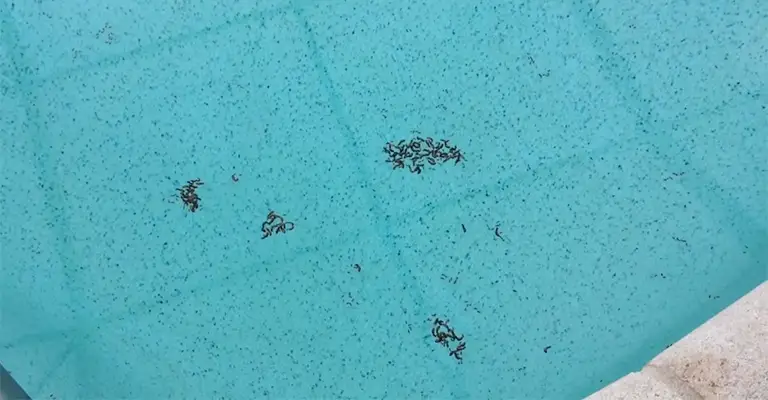Dealing with pesky dead gnats floating in your pool can quickly turn a relaxing swim into an unpleasant experience. If you’ve been grappling with this issue, you’re not alone.
While at first glance, these specks may appear to be dirt, closer examination may reveal that they actually are dead gnats.
It is not an experience that most people want to endure to swim with dead gnats in the pool.
Even though dead gnats can be easily removed from pools, if they are left floating for too long, they will eventually cause a problem.
The purpose of this post is to explain why there might be dead gnats in your pool, as well as some tips for keeping them away in the first place.
How to Get Rid of Gnats Around Pool?
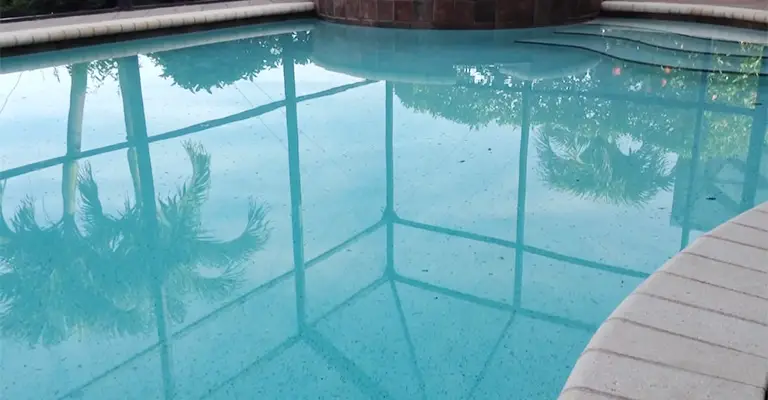
A pool’s best defense against dead gnats is to remove them from the area around the pool. You can get rid of gnats around the pool by following these steps:
1. Natural Repellents
Keeping gnats away from your pool area is easier when you use natural repellents. Several plants and essential oils can be used as repellents, including citronella candles.
Gnats, mosquitoes, and other insects will stay away from your pool and garden if you have lavender, rosemary, or peppermint plants.
2. Use Vinegar
If you deal with gnats around the pool, you will find this tip to be very helpful. The vinegar should be placed in plastic bottles near the water and holes poked in the lids.
If any curious gnats pop by, they will crawl in through the holes, but will be unable to fly away. A bug trap that works instantly!
3. Use a Pool Cover
An excellent way to keep gnats out of the pool is to install a pool cover. By covering the water, they are physically prevented from entering.
A pool cover can also reduce the amount of sunlight that enters the pool. The sun’s rays can provide favorable conditions for gnats to lay eggs on water.
4. Use Fans
Due to their weakness as flyers, gnats can be kept away by the wind around a swimming pool. In addition to preventing gnats, strategically placed fans can provide guests with a pleasant breeze.
Fans come in many different types, including ceiling, box, tower, and high velocity fans. In order to ensure safety, it’s imperative that all installed fans are rated for outdoor use.
5. Remove Nearby Standing Water
Gnats can breed in stagnant water. Ensure that there is no standing water near the pool area, such as birdbaths, buckets, or other containers.
Consider adding circulation to your pond, such as a pump, in order to prevent gnats from breeding there.
There may be standing water in a pool as a result of leaking pool equipment. In order to prevent gnats from being attracted to moisture, you should fix any drips you notice.
6. Keep the Pool Clean
Organic matter, such as leaves and other debris, is a source of food for gnats, including their larvae. The pool should be kept clean to keep gnats away.
It is important to skim and vacuum your swimming pool regularly in order to keep gnats away.
7. Proper Water Chemistry
The pH, chlorine, and alkalinity levels of the pool water should be properly balanced to keep gnats at bay.
It is often found that fungus gnats prefer acidic environments with a pH between 5.0 and 7.0. The pH of pool water should be 7.2 to 7.4 to prevent these insects from infesting the pool.
8. Chemical Treatments
There are times when chemical treatments are necessary, even though natural options are often preferable.
Use insecticides specifically formulated for pool use. Pools are generally safe when treated with Pyrethin, which is derived from chrysanthemum flowers.
As another common insecticide, Bti (Bacillus thuringiensis israelensis) is generally effective against gnats and mosquito larvae. The product is also considered safe for humans, pets, and other insects.
9. Gnat Traps
It is possible to purchase gnat traps and place them around the pool. A sticky surface prevents gnats from escaping from many of these traps, which contain an attractant.
Even though store-bought traps work well, you can also build your own traps using regular household items.
10. Lighting
UV lighting attracts gnats and other insects. You might want to consider replacing the lights around the pool area with yellow or LED lights.
The UV will be reduced, and gnats will be less attracted to them. On the other hand, a bug zapper that uses UV lighting near the pool will attract gnats to be electrocuted by the light.
11. Maintain Landscaping
Gnats can be less likely to breed and feed on vegetation if it is kept trimmed and maintained.
By removing decaying leaves and other debris around the pool, you can eliminate a source of food for many types of larvae, including biting gnats.
Why There Are Dead Gnats in Pool?
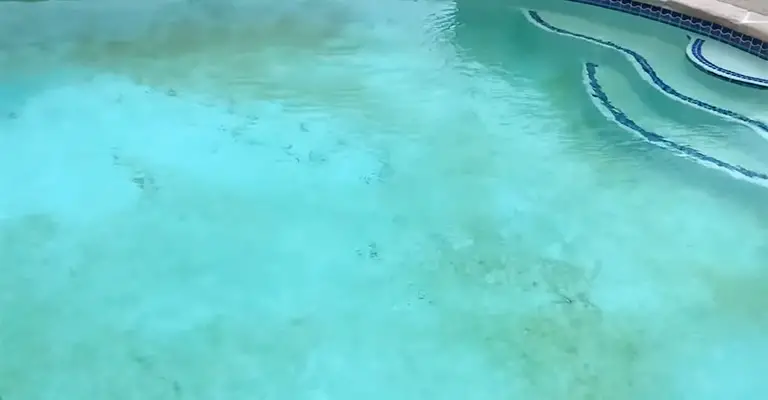
At first glance, dead gnats in the pool might seem insignificant. Why do gnats die in pools even though they are flying insects?
Many species of gnats prefer bodies of water as a natural habitat. These tiny insects can also be attracted by the reflections of light bouncing off the water.
Gnats are capable of flying away from the pool. However, there are several reasons why they might drown.
1. Water Chemistry
To avoid algae growth and other unwanted growth, pools are treated with chemicals, such as chlorine. When gnats or other insects come into contact with these chemicals, they can be severely harmed.
2. Suffocation
It is impossible for gnats to swim. A prolonged period of time in the pool can cause them to suffocate, even if they float for a while.
3. Exhaustion
Some gnat species can fly several hundred feet to a couple of miles, depending on their species. Insects expend energy whenever they fly.
Especially if they can’t find a suitable resting spot, flying for extended periods can exhaust them. When exhausted gnats float on the surface of a pool, they may not be able to return to flight before they die.
4. Surface Tension
Due to the surface tension of the water, a gnat may not be able to escape once it lands on the surface of the water.
Their delicate wings may not be able to break free from the water’s hold because of the surface tension.
How to Get Rid of Dead Gnats in the Pool?
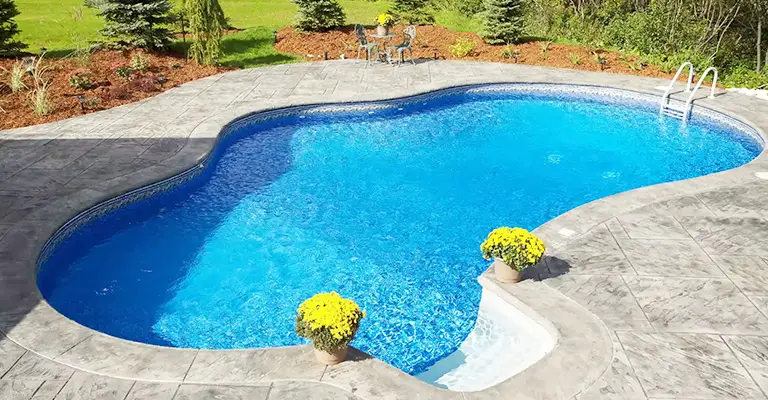
A swarm of gnats may consist of a few dozen to several thousand individuals. Since gnats’ exoskeletons are light in density, dead gnats will usually float rather than sink to the bottom.
It may not be noticeable to see a few dead gnats in the pool, but thousands are an eyesore.
While dead gnats are visually detracting, they also provide nutrients to algae and bacteria during the decomposition process.
It’s especially important to remove dead gnats from the pool if there are a large number and they’re affecting the water’s chemistry.
There are a few simple steps you can follow to remove dead gnats from your pool:
- Sweep the surface of the water to remove dead gnats with a skimmer net.
- Empty the skimmer basket if your pool has one. Gnats can reduce the effectiveness of a skimmer if there is a large load of dead ones.
- Gently scrub the pool walls at the waterline with a pool brush to remove any dead gnats that may be clinging to them.
- Check to see if the filter pressure has risen too high. There is a possibility that the filter is clogged with gnats that have gotten past the skimmer basket.
- Make sure the water balance is right, especially if there have been dead gnats decomposing for some time.
What Are Gnats?
Firstly, let’s understand what a gnat is in order to understand why they might be in the pool.
It is estimated that there are over 3,000 species of gnats in the world. In the United States alone, there are more than 1,200 species of gnats.
Gnats have a head, thorax, abdomen, and antennae like other insects. During flight, they can cover moderate distances of several miles using just one pair of wings.
They typically measure between 3 and 6 mm, although their appearance may vary depending on the species. Their mouths are designed to allow sucking – such as nectar, sap, and blood.
There are many different colors of gnats, but sometimes even yellow gnats are seen.
Metamorphosis is the process by which gnats reproduce, meaning they go through egg, larva, pupa, and adult stages.
It is common for their larvae to be legless and worm-like, and are called “maggots” by many people.
It is generally during the summer months that gnat populations thrive, while they may be active in the spring and fall as well. Their breeding is favored by the warmth and humidity.
What Do Gnats Eat?
Gnats’ diet will vary depending on their species and stage of development. It is possible for insects to eat nectar, decaying organic matter, or fungi depending on their species.
The larval stage of gnats often develops in water while eating decaying matter. Nectar and other plant substances are the primary sources of nutrition for adult gnats.
Blood is the main food source for female biting gnats, such as black flies and no-see-ums. Both animals and humans are included in this category.
There are also some gnat species that prefer wet environments. It is common to find such gnats near damp soil or water. There are still some gnats that prefer pool water even though they prefer natural sources of water.
How To Identify Gnats In Pool Water?
Your pool may be the ideal place for gnats to lay their eggs due to their preference for damp places. It is hard to deal with gnats in and out of the water because of two things:
It is not just one or two bugs you will be dealing with, but an obnoxious cloud of them as they move in swarms.
Instead of sucking blood from the surface of the skin, these insects slice through it to reach the target. Gnat “bite” can therefore be painful and itchy.
What is the best way to tell if your pool has gnats?
A gnat’s tendency to swarm is one way to identify it. It is likely that you have gnats if you see a swarm of bugs flitting around your plants.
Preventing Swimming Pool Pests
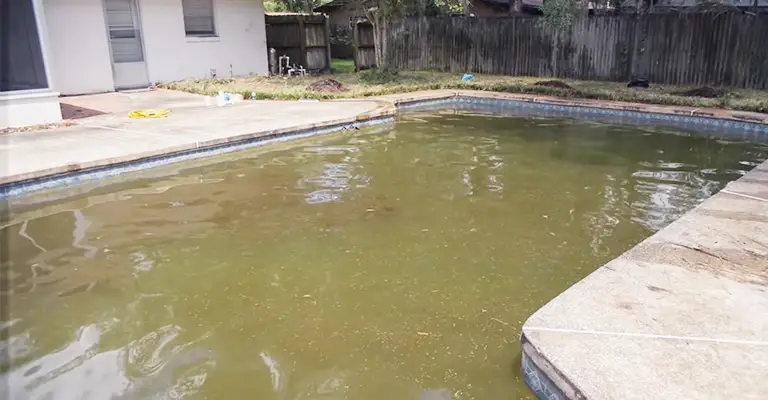
Is it possible to keep your pool pest-free if you do not have any? You can prevent pool bugs by following these tips.
1. Avoid Plantation Near The Pool
In some cases, the bugs in the list above don’t live in water or don’t feed there. Your yard’s plants are their food source instead.
Keeping your plant beds away from your pool will reduce the likelihood of bugs making the trip there to feed on them.
Make sure the area around the pool is clean and clear of plants–even overhanging trees, if necessary.
2. Avoid Placing Lighting Near The Pool
Did you know that bugs are attracted to light at night? Those lights! The best way to keep any lighting away from the edge of the pool is to keep it at least 30 feet from it.
The use of citronella candles can help you achieve both objectives at once if you need better lighting for night swimming.
3. Trash Can Go Somewhere Else
Trash attracts bugs as well. Make sure your garbage cans are placed at the farthest possible point from your pool.
4. Clear Standing Water
Obviously, there’s standing water in the pool, but all that regular maintenance is for that purpose. It is not a good idea to dump or clean anything that has standing water or dampness.
There are a number of things that can collect water, such as birdbaths, pet water dishes, wheelbarrows and outdoor toys.
You should regularly clear your gutters and aerate your lawn to prevent damp spots.
You can make your time near the pool more enjoyable by taking these swimming pool mosquito control steps.
Final Words
Gnats are capable of flying, so finding dead gnats in the pool may surprise you. Their delicate wings, however, are often incapable of overcoming the surface tension in the water, preventing them from escaping.
Some dead gnats are just a minor annoyance that can easily be cleaned up. When large quantities of dead gnats are left floating in a pool, the problem can snowball.
Decomposing dead gnats in the pool can disrupt the chemistry of the water, which is so vital to good swimming. In addition, if they aren’t removed, they could clog the filtration system.
The good news is that similar to termites and other insects, gnats around a pool can be eliminated with targeted treatments and preventative measures. Taking a combination of measures can further improve success rates.

